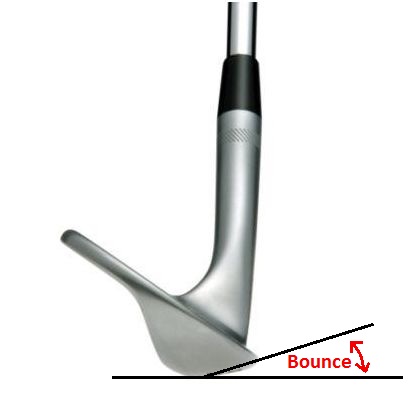Understanding wedge bounce will improve your chipping and short pitch shots. What is wedge bounce? Here’s a definition from www.vokey.com, “Wedge bounce is the angle created between the leading edge and the lowest point of the sole of trailing edge. This is the area of the club that hits through the ground as it contacts the ball.”

This picture clearly shows exactly what wedge bounce is. As can be seen in the photography, the leading edge of the clubface is higher than the trailing edge of the sole. The angle between the leading edge and the lowest part of the sole is the bounce angle. Why and how can this bounce angle improve chipping and short pitch shots? There are two major faults that occur with these short shots, the chunk, and the blade. The chunk occurs when the leading-edge digs into the ground, stops and the ball goes just a foot or two. The bladed shot happens when the leading edge hits the ball near the equator sending it screaming across the green. Often, the bladed shot results from an attempt to not chunk it!
Study the picture closely. If we contact the ball with the shaft vertical, or nearly vertical (the true loft of the club) the bounce will allow the sole of the club to contact the ground, not the leading edge. The club will continue to slide along the ground and not dig into the turf. The chunk is gone! With no fear of the chunk, the chances of blading the shot are greatly reduced. Most of us have been taught to play chip shots with the ball back in the stance, hands forward, and strike down on the ball. This is a valid technique, but only in certain circumstances and provides virtually no margin of error. If you’re comfortable with this shot and it works for you, don’t feel you need to change. However, if you do suffer from chunks and bladed shots, there is another option.
Address the ball in the middle of your stance with the shaft vertical. Swing the club back with very little wrist break. As you return to impact, ensure the shaft is again vertical, feel the bounce slide along the ground under the ball. For short chips, this might feel almost like a long putting stroke. On longer chips and pitches some wrist action can be added, but the shaft must return to vertical (or near-vertical) at impact. This is a very forgiving way to use your wedges around the green. If you happen to hit it a bit fat, that is behind the ball, the bounce will save you. The club will not dig in but slide along under the ball. Just keep the clubhead moving through the shot. As with anything new, it will take some time and practice to get the hang of it, but, when you do, you’ll be happy with the results.
